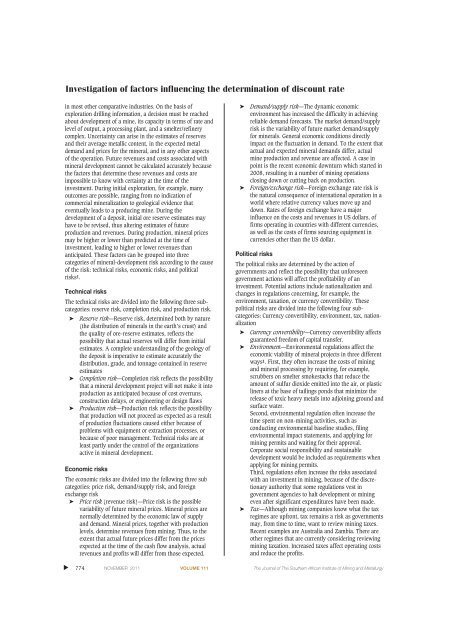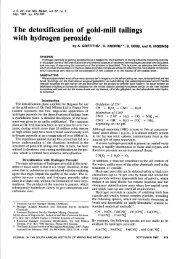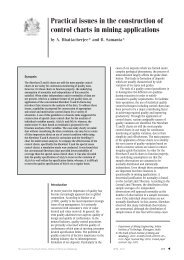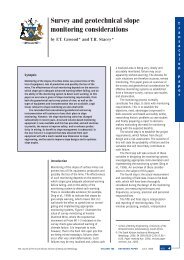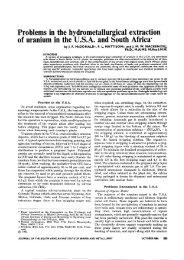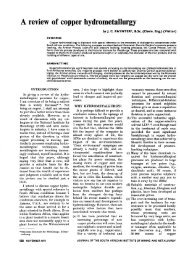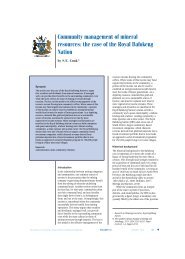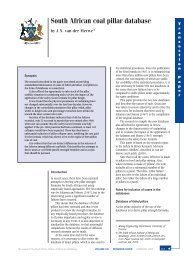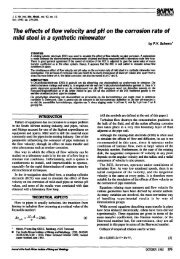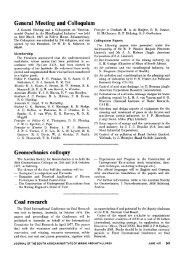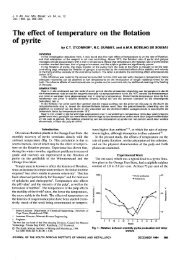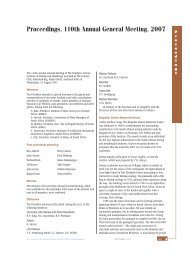Investigation of factors influencing the determination of ... - saimm
Investigation of factors influencing the determination of ... - saimm
Investigation of factors influencing the determination of ... - saimm
You also want an ePaper? Increase the reach of your titles
YUMPU automatically turns print PDFs into web optimized ePapers that Google loves.
<strong>Investigation</strong> <strong>of</strong> <strong>factors</strong> <strong>influencing</strong> <strong>the</strong> <strong>determination</strong> <strong>of</strong> discount rate<br />
in most o<strong>the</strong>r comparative industries. On <strong>the</strong> basis <strong>of</strong><br />
exploration drilling information, a decision must be reached<br />
about development <strong>of</strong> a mine, its capacity in terms <strong>of</strong> rate and<br />
level <strong>of</strong> output, a processing plant, and a smelter/refinery<br />
complex. Uncertainty can arise in <strong>the</strong> estimates <strong>of</strong> reserves<br />
and <strong>the</strong>ir average metallic content, in <strong>the</strong> expected metal<br />
demand and prices for <strong>the</strong> mineral, and in any o<strong>the</strong>r aspects<br />
<strong>of</strong> <strong>the</strong> operation. Future revenues and costs associated with<br />
mineral development cannot be calculated accurately because<br />
<strong>the</strong> <strong>factors</strong> that determine <strong>the</strong>se revenues and costs are<br />
impossible to know with certainty at <strong>the</strong> time <strong>of</strong> <strong>the</strong><br />
investment. During initial exploration, for example, many<br />
outcomes are possible, ranging from no indication <strong>of</strong><br />
commercial mineralization to geological evidence that<br />
eventually leads to a producing mine. During <strong>the</strong><br />
development <strong>of</strong> a deposit, initial ore reserve estimates may<br />
have to be revised, thus altering estimates <strong>of</strong> future<br />
production and revenues. During production, mineral prices<br />
may be higher or lower than predicted at <strong>the</strong> time <strong>of</strong><br />
investment, leading to higher or lower revenues than<br />
anticipated. These <strong>factors</strong> can be grouped into three<br />
categories <strong>of</strong> mineral-development risk according to <strong>the</strong> cause<br />
<strong>of</strong> <strong>the</strong> risk: technical risks, economic risks, and political<br />
risks1.<br />
Technical risks<br />
The technical risks are divided into <strong>the</strong> following three subcategories:<br />
reserve risk, completion risk, and production risk.<br />
➤ Reserve risk—Reserve risk, determined both by nature<br />
(<strong>the</strong> distribution <strong>of</strong> minerals in <strong>the</strong> earth’s crust) and<br />
<strong>the</strong> quality <strong>of</strong> ore-reserve estimates, reflects <strong>the</strong><br />
possibility that actual reserves will differ from initial<br />
estimates. A complete understanding <strong>of</strong> <strong>the</strong> geology <strong>of</strong><br />
<strong>the</strong> deposit is imperative to estimate accurately <strong>the</strong><br />
distribution, grade, and tonnage contained in reserve<br />
estimates<br />
➤ Completion risk—Completion risk reflects <strong>the</strong> possibility<br />
that a mineral development project will not make it into<br />
production as anticipated because <strong>of</strong> cost overruns,<br />
construction delays, or engineering or design flaws<br />
➤ Production risk—Production risk reflects <strong>the</strong> possibility<br />
that production will not proceed as expected as a result<br />
<strong>of</strong> production fluctuations caused ei<strong>the</strong>r because <strong>of</strong><br />
problems with equipment or extraction processes, or<br />
because <strong>of</strong> poor management. Technical risks are at<br />
least partly under <strong>the</strong> control <strong>of</strong> <strong>the</strong> organizations<br />
active in mineral development.<br />
Economic risks<br />
The economic risks are divided into <strong>the</strong> following three sub<br />
categories: price risk, demand/supply risk, and foreign<br />
exchange risk<br />
➤ Price risk (revenue risk)—Price risk is <strong>the</strong> possible<br />
variability <strong>of</strong> future mineral prices. Mineral prices are<br />
normally determined by <strong>the</strong> economic law <strong>of</strong> supply<br />
and demand. Mineral prices, toge<strong>the</strong>r with production<br />
levels, determine revenues from mining. Thus, to <strong>the</strong><br />
extent that actual future prices differ from <strong>the</strong> prices<br />
expected at <strong>the</strong> time <strong>of</strong> <strong>the</strong> cash flow analysis, actual<br />
revenues and pr<strong>of</strong>its will differ from those expected.<br />
➤<br />
➤<br />
Demand/supply risk—The dynamic economic<br />
environment has increased <strong>the</strong> difficulty in achieving<br />
reliable demand forecasts. The market demand/supply<br />
risk is <strong>the</strong> variability <strong>of</strong> future market demand/supply<br />
for minerals. General economic conditions directly<br />
impact on <strong>the</strong> fluctuation in demand. To <strong>the</strong> extent that<br />
actual and expected mineral demands differ, actual<br />
mine production and revenue are affected. A case in<br />
point is <strong>the</strong> recent economic downturn which started in<br />
2008, resulting in a number <strong>of</strong> mining operations<br />
closing down or cutting back on production.<br />
Foreign/exchange risk—Foreign exchange rate risk is<br />
<strong>the</strong> natural consequence <strong>of</strong> international operation in a<br />
world where relative currency values move up and<br />
down. Rates <strong>of</strong> foreign exchange have a major<br />
influence on <strong>the</strong> costs and revenues in US dollars, <strong>of</strong><br />
firms operating in countries with different currencies,<br />
as well as <strong>the</strong> costs <strong>of</strong> firms sourcing equipment in<br />
currencies o<strong>the</strong>r than <strong>the</strong> US dollar.<br />
Political risks<br />
The political risks are determined by <strong>the</strong> action <strong>of</strong><br />
governments and reflect <strong>the</strong> possibility that unforeseen<br />
government actions will affect <strong>the</strong> pr<strong>of</strong>itability <strong>of</strong> an<br />
investment. Potential actions include nationalization and<br />
changes in regulations concerning, for example, <strong>the</strong><br />
environment, taxation, or currency convertibility. These<br />
political risks are divided into <strong>the</strong> following four subcategories:<br />
Currency convertibility, environment, tax, nationalization<br />
➤ Currency convertibility—Currency convertibility affects<br />
guaranteed freedom <strong>of</strong> capital transfer.<br />
➤ Environment—Environmental regulations affect <strong>the</strong><br />
economic viability <strong>of</strong> mineral projects in three different<br />
ways1. First, <strong>the</strong>y <strong>of</strong>ten increase <strong>the</strong> costs <strong>of</strong> mining<br />
and mineral processing by requiring, for example,<br />
scrubbers on smelter smokestacks that reduce <strong>the</strong><br />
amount <strong>of</strong> sulfur dioxide emitted into <strong>the</strong> air, or plastic<br />
liners at <strong>the</strong> base <strong>of</strong> tailings ponds that minimize <strong>the</strong><br />
release <strong>of</strong> toxic heavy metals into adjoining ground and<br />
surface water.<br />
Second, environmental regulation <strong>of</strong>ten increase <strong>the</strong><br />
time spent on non-mining activities, such as<br />
conducting environmental baseline studies, filing<br />
environmental impact statements, and applying for<br />
mining permits and waiting for <strong>the</strong>ir approval.<br />
Corporate social responsibility and sustainable<br />
development would be included as requirements when<br />
applying for mining permits.<br />
Third, regulations <strong>of</strong>ten increase <strong>the</strong> risks associated<br />
with an investment in mining, because <strong>of</strong> <strong>the</strong> discretionary<br />
authority that some regulations vest in<br />
government agencies to halt development or mining<br />
even after significant expenditures have been made.<br />
➤ Tax—Although mining companies know what <strong>the</strong> tax<br />
regimes are upfront, tax remains a risk as governments<br />
may, from time to time, want to review mining taxes.<br />
Recent examples are Australia and Zambia. There are<br />
o<strong>the</strong>r regimes that are currently considering reviewing<br />
mining taxation. Increased taxes affect operating costs<br />
and reduce <strong>the</strong> pr<strong>of</strong>its.<br />
▲<br />
774 NOVEMBER 2011 VOLUME 111 The Journal <strong>of</strong> The Sou<strong>the</strong>rn African Institute <strong>of</strong> Mining and Metallurgy


